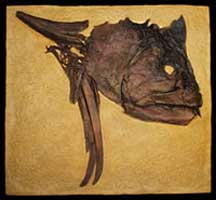Xiphactinus audax, formerly known as Portheus molossus, is an extinct predatory fish found in Late Cretaceous deposits of North America and Europe. Xiphactinus belongs to an extinct group of fish known as ichthyodectids. They had powerful jaws and tails, making them efficient predators. Weighing up to 800 pounds and reaching lengths of up to 18 feet, Xiphactinus was the largest of the ichthyodectids. Xiphactinus is easily recognized by its fang-like teeth and elongated body, superficially resembling a modern tarpon. Xiphactinus often swallowed prey whole, sometimes leading to its own demise. A few Xiphactinus specimens have been found with undigested remains of large fish in the stomach cavity. Xiphactinus was one of the most fearsome predators of Late Cretaceous oceans.
During the Late Cretaceous, North America was divided by a great inland sea (known as the Western Interior Seaway) which stretched from the Gulf of Mexico to the Arctic Circle. Vast layers of chalk were deposited in this shallow sea, leading to remarkable preservation of its inhabitants. The chalk beds of western Kansas, known as the Niobrara Formation are world famous for yielding some of the finest fossils of Late Cretaceous marine and flying reptiles, birds, fish, sharks, and invertebrates.
This is a replica of an 80 million year old specimen found in the Niobrara Formation of western Kansas. The original fossil was discovered and prepared by famed fossil hunter George F. Sternberg. Sternberg collected extensively in the chalk deposits of Kansas, providing many museums with display specimens and greatly contributing to the wealth of knowledge of the Niobrara Formation.
This replica was cast from original fossil material with exclusive permission from the Fick Fossil and History Museum. The original specimen is on display at Fick Fossil and History Museum, 700 W. Third, Oakley, KS 67749, (785) 672-4839, www.oakley-kansas.com/fick/
The original for this Xiphactinus specimen resides in a museum in Kansas. I have seen original specimens of this species about half the size of this one and no where near the quality sell for over $7,000.00.
Xiphactinus audax 
Quantity in Basket: None
Code: OST-300
Price: $905.00
Shipping Weight: 34.95 pounds
Time: Late Cretaceous approximately 80 million years ago.
Location: Niobrara Formation of Kansas, USA
Dimensions: 29-1/2" x 27" x 2-1/2"
*Please note, the delivery time may be up to 6 weeks.